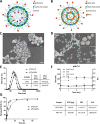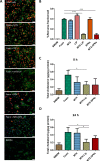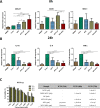Modulating Lipoprotein Transcellular Transport and Atherosclerotic Plaque Formation in ApoE-/- Mice via Nanoformulated Lipid-Methotrexate Conjugates
- PMID: 32805983
- PMCID: PMC7453397
- DOI: 10.1021/acsami.0c12202
Modulating Lipoprotein Transcellular Transport and Atherosclerotic Plaque Formation in ApoE-/- Mice via Nanoformulated Lipid-Methotrexate Conjugates
Abstract
Macrophage inflammation and maturation into foam cells, following the engulfment of oxidized low-density lipoproteins (oxLDL), are major hallmarks in the onset and progression of atherosclerosis. Yet, chronic treatments with anti-inflammatory agents, such as methotrexate (MTX), failed to modulate disease progression, possibly for the limited drug bioavailability and plaque deposition. Here, MTX-lipid conjugates, based on 1,2-distearoyl-sn-glycero-3-phosphoethanolamine (DSPE), were integrated in the structure of spherical polymeric nanoparticles (MTX-SPNs) or intercalated in the lipid bilayer of liposomes (MTX-LIP). Although, both nanoparticles were colloidally stable with an average diameter of ∼200 nm, MTX-LIP exhibited a higher encapsulation efficiency (>70%) and slower release rate (∼50% at 10 h) compared to MTX-SPN. In primary bone marrow derived macrophages (BMDMs), MTX-LIP modulated the transcellular transport of oxLDL more efficiently than free MTX mostly by inducing a 2-fold overexpression of ABCA1 (regulating oxLDL efflux), while the effect on CD36 and SRA-1 (regulating oxLDL influx) was minimal. Furthermore, in BMDMs, MTX-LIP showed a stronger anti-inflammatory activity than free MTX, reducing the expression of IL-1β by 3-fold, IL-6 by 2-fold, and also moderately of TNF-α. In 28 days high-fat-diet-fed apoE-/- mice, MTX-LIP reduced the mean plaque area by 2-fold and the hematic amounts of RANTES by half as compared to free MTX. These results would suggest that the nanoenhanced delivery to vascular plaques of the anti-inflammatory DSPE-MTX conjugate could effectively modulate the disease progression by halting monocytes' maturation and recruitment already at the onset of atherosclerosis.
Keywords: atherosclerosis; foam cells; inflammation; low-density lipoprotein transport; nanomedicine.
Conflict of interest statement
The authors declare no competing financial interest.
Figures





Similar articles
-
Nucleolin protects macrophages from oxLDL-induced foam cell formation through up-regulating ABCA1 expression.Biochem Biophys Res Commun. 2017 Apr 29;486(2):364-371. doi: 10.1016/j.bbrc.2017.03.047. Epub 2017 Mar 14. Biochem Biophys Res Commun. 2017. PMID: 28315324
-
Methotraxate-Loaded Hybrid Nanoconstructs Target Vascular Lesions and Inhibit Atherosclerosis Progression in ApoE-/- Mice.Adv Healthc Mater. 2017 Jul;6(13). doi: 10.1002/adhm.201601286. Epub 2017 Apr 12. Adv Healthc Mater. 2017. PMID: 28402587
-
Rice bran active peptide (RBAP) inhibited macrophage differentiation to foam cell and atherosclerosis in mice via regulating cholesterol efflux.Phytomedicine. 2024 Sep;132:155864. doi: 10.1016/j.phymed.2024.155864. Epub 2024 Jul 14. Phytomedicine. 2024. PMID: 39032281
-
Foam cells in atherosclerosis.Clin Chim Acta. 2013 Sep 23;424:245-52. doi: 10.1016/j.cca.2013.06.006. Epub 2013 Jun 16. Clin Chim Acta. 2013. PMID: 23782937 Review.
-
Challenges and advances in the management of inflammation in atherosclerosis.J Adv Res. 2025 May;71:317-335. doi: 10.1016/j.jare.2024.06.016. Epub 2024 Jun 22. J Adv Res. 2025. PMID: 38909884 Free PMC article. Review.
Cited by
-
Nanoparticles in the diagnosis and treatment of vascular aging and related diseases.Signal Transduct Target Ther. 2022 Jul 11;7(1):231. doi: 10.1038/s41392-022-01082-z. Signal Transduct Target Ther. 2022. PMID: 35817770 Free PMC article. Review.
-
Research progress on the therapeutic effects of nanoparticles loaded with drugs against atherosclerosis.Cardiovasc Drugs Ther. 2024 Oct;38(5):977-997. doi: 10.1007/s10557-023-07461-0. Epub 2023 May 13. Cardiovasc Drugs Ther. 2024. PMID: 37178241 Review.
-
Reduced Uptake of Oxidized Low-Density Lipoprotein by Macrophages Using Multiple Aptamer Combinations.ACS Appl Bio Mater. 2025 Jan 20;8(1):457-474. doi: 10.1021/acsabm.4c01432. Epub 2025 Jan 6. ACS Appl Bio Mater. 2025. PMID: 39762152 Free PMC article.
-
The Impact of Cytokines in Coronary Atherosclerotic Plaque: Current Therapeutic Approaches.Int J Mol Sci. 2022 Dec 14;23(24):15937. doi: 10.3390/ijms232415937. Int J Mol Sci. 2022. PMID: 36555579 Free PMC article. Review.
-
Biomimetic nanoparticles to enhance the reverse cholesterol transport for selectively inhibiting development into foam cell in atherosclerosis.J Nanobiotechnology. 2023 Aug 29;21(1):307. doi: 10.1186/s12951-023-02040-9. J Nanobiotechnology. 2023. PMID: 37644442 Free PMC article.
References
-
- Libby P.; Hansson G. K.. Taming Immune and Inflammatory Responses to Treat Atherosclerosis. Journal of the American College of Cardiology 2018. - PubMed
-
- Kim Y.; Lobatto M. E.; Kawahara T.; Lee Chung B.; Mieszawska A. J.; Sanchez-Gaytan B. L.; Fay F.; Senders M. L.; Calcagno C.; Becraft J.; Tun Saung M.; Gordon R. E.; Stroes E. S. G.; Ma M.; Farokhzad O. C.; Fayad Z. A.; Mulder W. J. M.; Langer R. Probing Nanoparticle Translocation across the Permeable Endothelium in Experimental Atherosclerosis. Proc. Natl. Acad. Sci. U. S. A. 2014, 111, 1078–1083. 10.1073/pnas.1322725111. - DOI - PMC - PubMed
MeSH terms
Substances
Grants and funding
LinkOut - more resources
Full Text Sources
Research Materials
Miscellaneous

